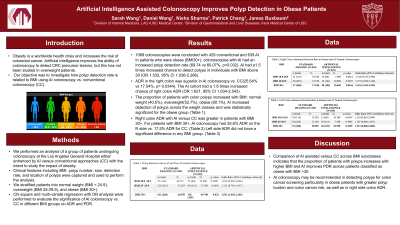Monday Poster Session
Category: Obesity
P3172 - AI Assisted Colonoscopy Improves Polyp Detection in Obese Patients
Monday, October 28, 2024
10:30 AM - 4:00 PM ET
Location: Exhibit Hall E

Has Audio

Sarah J. Wang, MD, MPH
University of Southern California
Los Angeles, CA
Presenting Author(s)
Sarah J. Wang, MD, MPH1, Daniel Wang, MD1, Patrick Chang, MD1, Omar Bakr, MD, MPH2, Nisha Sharma, MD1, Denis Nguyen, MD2, Niwen Kong, MD1, Maziar Amini, MD1, Justin Ong, MD1, Dara Bruce, MSc3, Helen Lee, NP2, Jennifer Phan, MD1, Liyun Yuan, MD, PhD2, Ara Sahakian, MD2, James Buxbaum, MD2
1University of Southern California, Los Angeles, CA; 2Keck School of Medicine of the University of Southern California, Los Angeles, CA; 3Keck School of Medicine of the University of Southern California, Glendale, CA
Introduction: Obesity is a worldwide health crisis and increases the risk of colorectal cancer. Artificial intelligence improves the ability of colonoscopy to detect CRC precursor lesions, but this has not been studied in overweight patients. Our objective was to investigate how polyp detection rate is related to BMI using AI colonoscopy vs. conventional colonoscopy (CC).
Methods: We performed an analysis of a group of patients undergoing colonoscopy at the Los Angeles General Hospital either enhanced by AI versus conventional approaches (CC) with the intent to study the impact of obesity. Clinical features including BMI, polyp number, size, detection rate, and location of polyps were captured and used to perform the analysis. We stratified patients into normal weight (BMI < 24.9), overweight (BMI 25-29.9), and obese (BMI 30+). Chi-square and multi-variate regression with OR analysis were performed to evaluate the significance of AI colonoscopy vs. CC in different BMI groups on ADR and PDR.
Results: 1068 colonoscopies were conducted with 429 conventional and 639 AI. In patients who were obese (BMI 30+), colonoscopies with AI had an increased polyp detection rate (69.74 vs 60.07%, p=0.032). AI had a 1.5 times increased chance to detect polyps in individuals with BMI above 30 (OR 1.532, 95% CI 1.036-2.266). In addition, rate of adenoma detection in the right colon was superior in AI colonoscopy vs. CC (25.64% vs 17.54%, p= 0.0344). The AI cohort had a 1.6 times increased chance of right colon adenoma detection (OR 1.621, 95% CI 1.034-2.543).
The proportion of patients with colon polyps increased with BMI: normal weight (40.5%), overweight (52.7%), obese (60.1%). AI increased detection of polyps across the weight classes and was statistically significant for the obese group (Table 1).
Right colon adenoma detection rate with AI versus CC was greater in patients with BMI 30+. For patients with BMI 30+, AI colonoscopy had 25.6% ADR on the R side vs. 17.5% ADR for CC. (Table 2) Left side colon adenoma detection rate did not have a significant difference in any BMI group. (Table 3)
Discussion: Comparison of AI assisted versus CC across BMI subclasses indicates that the proportion of patients with polyps increases with higher BMI and AI improves PDR across patients classified as obese with BMI > 30. AI colonoscopy may be recommended in detecting polyps for colon cancer screening particularly in obese patients with greater polyp burden and colon cancer risk, as well as in right side colon ADR.
Note: The table for this abstract can be viewed in the ePoster Gallery section of the ACG 2024 ePoster Site or in The American Journal of Gastroenterology's abstract supplement issue, both of which will be available starting October 27, 2024.
Disclosures:
Sarah J. Wang, MD, MPH1, Daniel Wang, MD1, Patrick Chang, MD1, Omar Bakr, MD, MPH2, Nisha Sharma, MD1, Denis Nguyen, MD2, Niwen Kong, MD1, Maziar Amini, MD1, Justin Ong, MD1, Dara Bruce, MSc3, Helen Lee, NP2, Jennifer Phan, MD1, Liyun Yuan, MD, PhD2, Ara Sahakian, MD2, James Buxbaum, MD2. P3172 - AI Assisted Colonoscopy Improves Polyp Detection in Obese Patients, ACG 2024 Annual Scientific Meeting Abstracts. Philadelphia, PA: American College of Gastroenterology.
1University of Southern California, Los Angeles, CA; 2Keck School of Medicine of the University of Southern California, Los Angeles, CA; 3Keck School of Medicine of the University of Southern California, Glendale, CA
Introduction: Obesity is a worldwide health crisis and increases the risk of colorectal cancer. Artificial intelligence improves the ability of colonoscopy to detect CRC precursor lesions, but this has not been studied in overweight patients. Our objective was to investigate how polyp detection rate is related to BMI using AI colonoscopy vs. conventional colonoscopy (CC).
Methods: We performed an analysis of a group of patients undergoing colonoscopy at the Los Angeles General Hospital either enhanced by AI versus conventional approaches (CC) with the intent to study the impact of obesity. Clinical features including BMI, polyp number, size, detection rate, and location of polyps were captured and used to perform the analysis. We stratified patients into normal weight (BMI < 24.9), overweight (BMI 25-29.9), and obese (BMI 30+). Chi-square and multi-variate regression with OR analysis were performed to evaluate the significance of AI colonoscopy vs. CC in different BMI groups on ADR and PDR.
Results: 1068 colonoscopies were conducted with 429 conventional and 639 AI. In patients who were obese (BMI 30+), colonoscopies with AI had an increased polyp detection rate (69.74 vs 60.07%, p=0.032). AI had a 1.5 times increased chance to detect polyps in individuals with BMI above 30 (OR 1.532, 95% CI 1.036-2.266). In addition, rate of adenoma detection in the right colon was superior in AI colonoscopy vs. CC (25.64% vs 17.54%, p= 0.0344). The AI cohort had a 1.6 times increased chance of right colon adenoma detection (OR 1.621, 95% CI 1.034-2.543).
The proportion of patients with colon polyps increased with BMI: normal weight (40.5%), overweight (52.7%), obese (60.1%). AI increased detection of polyps across the weight classes and was statistically significant for the obese group (Table 1).
Right colon adenoma detection rate with AI versus CC was greater in patients with BMI 30+. For patients with BMI 30+, AI colonoscopy had 25.6% ADR on the R side vs. 17.5% ADR for CC. (Table 2) Left side colon adenoma detection rate did not have a significant difference in any BMI group. (Table 3)
Discussion: Comparison of AI assisted versus CC across BMI subclasses indicates that the proportion of patients with polyps increases with higher BMI and AI improves PDR across patients classified as obese with BMI > 30. AI colonoscopy may be recommended in detecting polyps for colon cancer screening particularly in obese patients with greater polyp burden and colon cancer risk, as well as in right side colon ADR.
Note: The table for this abstract can be viewed in the ePoster Gallery section of the ACG 2024 ePoster Site or in The American Journal of Gastroenterology's abstract supplement issue, both of which will be available starting October 27, 2024.
Disclosures:
Sarah Wang indicated no relevant financial relationships.
Daniel Wang indicated no relevant financial relationships.
Patrick Chang indicated no relevant financial relationships.
Omar Bakr indicated no relevant financial relationships.
Nisha Sharma indicated no relevant financial relationships.
Denis Nguyen indicated no relevant financial relationships.
Niwen Kong indicated no relevant financial relationships.
Maziar Amini indicated no relevant financial relationships.
Justin Ong indicated no relevant financial relationships.
Dara Bruce indicated no relevant financial relationships.
Helen Lee indicated no relevant financial relationships.
Jennifer Phan indicated no relevant financial relationships.
Liyun Yuan: Genfit – Grant/Research Support. Intercept – Grant/Research Support.
Ara Sahakian indicated no relevant financial relationships.
James Buxbaum indicated no relevant financial relationships.
Sarah J. Wang, MD, MPH1, Daniel Wang, MD1, Patrick Chang, MD1, Omar Bakr, MD, MPH2, Nisha Sharma, MD1, Denis Nguyen, MD2, Niwen Kong, MD1, Maziar Amini, MD1, Justin Ong, MD1, Dara Bruce, MSc3, Helen Lee, NP2, Jennifer Phan, MD1, Liyun Yuan, MD, PhD2, Ara Sahakian, MD2, James Buxbaum, MD2. P3172 - AI Assisted Colonoscopy Improves Polyp Detection in Obese Patients, ACG 2024 Annual Scientific Meeting Abstracts. Philadelphia, PA: American College of Gastroenterology.
